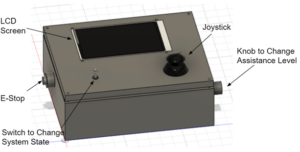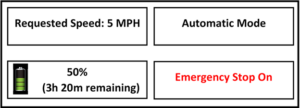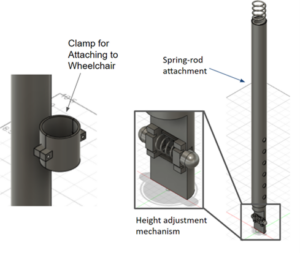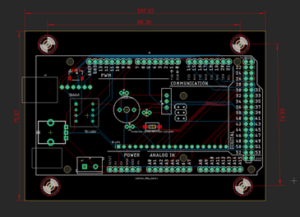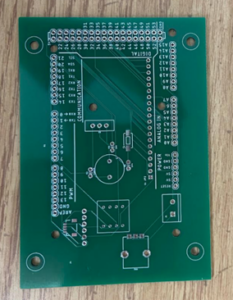The electro-mechanical integration team’s current design is a human centered adjustable interface that consists of a joystick, a toggle switch for three different modes, a potentiometer to set the speed, an E-stop for an emergency, and a LCD screen for displays. The interface inputs allow the user to control the speed, the mode they are in, and the direction they are going. The system is set up so that the screen is not obstructed by the switch or joystick at most angles. The emergency stop is located on the side of the device to allow for quick reaction time and the knob is located on the other side to allow the system to be easily adjusted to accommodate left and right-handed people.
In addition, the interface will have a LCD screen that allows the user to check the system’s status for things such as battery level, speed, and mode of operation. The LCD screen allows for the user to not have to remember how their wheelchair settings are configured.
The height of the interface can be adjusted using a spring loaded pin mechanism, similar to the ones found in crutches, so that this can be attached to various types of wheelchairs. A diagram of that can be found in Figure 12 below. A hinge will be attached to the bottom of the interface to allow the user to adjust the viewing angle in Figure 13a and 13b below. For some wheelchairs, the arm rest ends prior to the end of the wheelchair arm (Figure 4a). In order to allow the device to be attached to the far arm of the wheelchair and away from the wheel of the wheelchair, there is a second, smaller adjustment mechanism that functions similarly to the primary adjustment mechanism that allows the entire user interface to be raised to the level of the arm.
The design meets the current design specifications because the interface housing and beams are made of lightweight (Specification 2) and cost effective material (Specification 1) such as aluminum, is designed for both left and right handed users, and designed to be a retro-fit option. There is intent on preventing water damage to the electronics by designing a waterproof housing for the interface (Specification 5).
During the first semester, the EMI subteam was able to design and purchase a circuit board to accommodate all components of the interface, as seen in Figure 14 below. The majority of prefabricated components such as a joystick, a potentiometer, an e-stop, and an LCD screen and some supplemental components such as screws, wiring, and resistors were purchased. Although no physical prototype could be fabricated prior to the end of the semester, a complete CAD model of the user interface components and their housings have been made. The CAD model consists of a box that holds all of the electronics components and a rod-pin mechanism for attaching the interface to the wheelchair.
